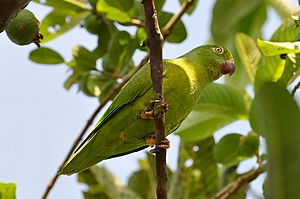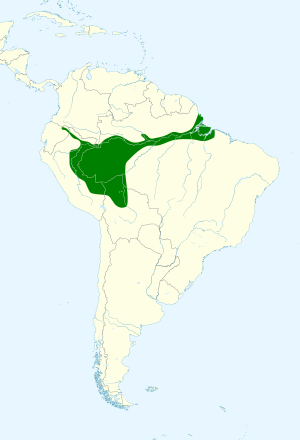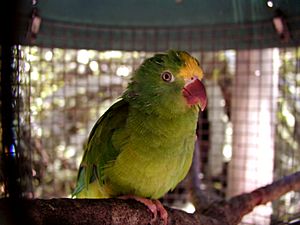Tui parakeet facts for kids
Quick facts for kids Tui parakeet |
|
|---|---|
 |
|
| At Uarini, Amazonas, Brazil | |
| Conservation status | |
| Scientific classification | |
| Genus: |
Brotogeris
|
| Species: |
sanctithomae
|
 |
|
The tui parakeet (Brotogeris sanctithomae) is a small, green parrot. It belongs to the parrot family, Psittacidae. You can find this bird in parts of Bolivia, Brazil, Colombia, and Peru. It might also live in Ecuador.
Contents
About the Tui Parakeet
What is a Tui Parakeet?
The tui parakeet is one of eight types of parakeets in the Brotogeris group. Scientists have identified two slightly different kinds, called subspecies. These are B. s. sanctithomae and B. s. takatsukasae.
What Does It Look Like?
Tui parakeets are about 17 to 19 centimeters (7 to 7.5 inches) long. They weigh around 59 grams (2 ounces). Most of their feathers are green. Their belly and lower back are a bit more yellow.
They have yellow feathers near their eyes and on their forehead. Their face might look a little blue. The long feathers on their wings are a darker green. The underside of these feathers is bluish. Their beak is brown.
The subspecies B. s. takatsukasae looks almost the same. The only difference is a small yellow stripe behind its eye. Young tui parakeets look just like the adults.
Where Tui Parakeets Live
Home and Habitat
The main subspecies, B. s. sanctithomae, lives in the Amazon Basin. This area includes southeastern Colombia, eastern Peru, northern Bolivia, and Brazil. It stretches east to the Rio Madeira river. Some people think they might also live in eastern Ecuador.
The other subspecies, B. s. takatsukasae, lives along the lower Amazon River. This area goes from the Rio Madeira and Rio Negro rivers all the way to the Atlantic Ocean.
Tui parakeets like to live in places that are partly open. This includes areas with new forests growing, grasslands with some trees, and riverbanks. They also like islands with thick bushes and the edges of forests that flood sometimes.
Tui Parakeet Behavior
Movement
Scientists believe that tui parakeets do not travel far. They tend to stay in the same area their whole lives.
What Do They Eat?
Tui parakeets eat fruits and flowers from many different plants. This includes palm trees. They also like to feed in farms that grow manioc and sugarcane.
Reproduction and Life Cycle
The breeding season for tui parakeets is not fully known. In Colombia, they seem to breed from April to July. They build their nests inside the nests of tree-dwelling termites. One nest was found with six baby birds inside. We don't know how many eggs they usually lay. We also don't know how long the eggs take to hatch or when the young birds leave the nest.
How They Communicate
Tui parakeets make several different sounds. Their calls include a high-pitched "klee" or a sharp "chree." They also make a two-part "chree-chree" sound. When they are in a group, they often make a fast chattering sound like "cra-cra-cra-cra-cra." Many birds in a flock will call out at the same time.
Tui Parakeet Population Status
The IUCN (International Union for Conservation of Nature) says the tui parakeet is a species of "Least Concern." This means they are not currently in danger of disappearing. They live across a large area. Even though we don't know the exact number of tui parakeets, their population seems to be stable. There are no big threats to them right now. They are common in Brazil and also in the smaller areas they live in Colombia, Peru, and Bolivia.
See also
 In Spanish: Catita frentigualda para niños
In Spanish: Catita frentigualda para niños



